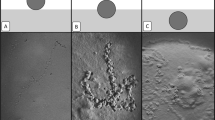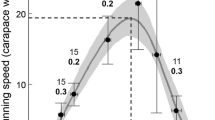Abstract
Intertidal organisms are vulnerable to global warming as they already live at, or near to, the upper limit of their thermal tolerance window. The behaviour of ectotherms could, however, dampen their limited physiological abilities to respond to climate change (e.g. drier and warmer environmental conditions) which could substantially increase their survival rates. The behaviour of ectotherms is still mostly overlooked in climate change studies. Here, we investigate the potential of aggregation behaviour to compensate for climate change in an intertidal gastropod species (Nerita atramentosa) in South Australia. We used thermal imaging to investigate (1) the heterogeneity in individual snail water content and body temperature and surrounding substratum temperature on two topographically different habitats (i.e. rock platform and boulders) separated by 250 m at both day- and night-times, (2) the potential relationship between environment temperature (air and substratum) and snail water content and body temperature, and (3) the potential buffering effect of aggregation behaviour on snail water content and body temperature. Both substratum and snail temperature were more heterogeneous at small spatial scales (a few centimetres to a few metres) than between habitats. This reinforces the evidence that mobile intertidal ectotherms could survive locally under warmer conditions if they can locate and move behaviourally in local thermal refuges. N. atramentosa behaviour, water content and body temperature during emersion seem to be related to the thermal stability and local conditions of the habitat occupied. Aggregation behaviour reduces both desiccation and heat stresses but only on the boulder field. Further investigations are required to identify the different behavioural strategies used by ectothermic species to adapt to heat and dehydrating conditions at the habitat level. Ultimately, this information constitutes a fundamental prerequisite to implement conservation management plans for ectothermic species identified as vulnerable in the warming climate.


Similar content being viewed by others
References
Benjamini Y, Yekutieli D (2001) The control of false discovery rate under dependency. Ann Stat 29:1165–1188
Bertness MD (1989) Intraspecific competition and facilitation in a northern acorn barnacle population. Ecology 70:257–268
Caddy-Retalic S, Benkendorff K, Fairweather PG (2011) Visualizing hotspots: applying thermal imaging to monitor internal temperatures in intertidal gastropods. Molluscan Res 31:106–113
Chapman MG, Underwood AJ (1992) Foraging behaviour of marine benthic grazers. In: John DM et al (eds) Plant–animal interactions in the marine benthos. Clarendon Press, Oxford, pp 289–317
Chapman MG, Underwood AJ (1996) Influences of tidal conditions, temperature and desiccation on patterns of aggregation of the high-shore periwinkle, Littorina unifasciata, in New South Wales, Australia. J Exp Mar Biol Ecol 196:213–237
Chapperon C, Seuront L (2009) Cue synergy in Littorina littorea navigation following wave dislodgement. J Mar Biol Assoc UK 89:1225–1228
Chapperon C, Seuront L (2011a) Space-time variability in environmental thermal properties and snail thermoregulatory behaviour. Funct Ecol 25:1040–1050
Chapperon C, Seuront L (2011b) Behavioural thermoregulation in a tropical gastropod: links to climate change scenarios. Glob Change Biol 17:1740–1749
Chase R, Croll RP, Zeichner LL (1980) Aggregation in snails, Achatina fulica. Behav Neural Biol 30:218–230
Chelazzi G, Della Santina P, Vannini M (1985) Long-lasting substrate marking in the collective homing of the gastropod Nerita textilis. Biol Bull 168:214–221
Chilton NB, Bull CM (1984) Influence of predation by a crab on the distribution of the size-groups of three intertidal gastropods in South Australia. Mar Biol 83:163–169
Coleman RA, Browne M, Theobalds T (2004) Aggregation as a defense: limpet tenacity changes in response to simulated predator attack. Ecology 85:1153–1159
Cox TE, Smith CM (2011) Thermal ecology on an exposed algal reef: infrared imagery a rapid tool to survey temperature at local spatial scales. Coral Reefs 30:1109–1120
CSIRO (2010) Climate variability and change in south-eastern Australia: a synthesis of findings from Phase 1 of the South Eastern Australian Climate Initiative (SEACI). http://www.csiro.au/~/Media/CSIROau/Divisions/CSIRO%20Land%20and%20Water/SynthesisReportSEACI_CLW_PDF%20Standard.pdf
Cudney-Bueno R, Prescott Hinojosa-Huerta O (2008) The black murex snail, Hexaplex Nigritus (Mollusca, Muricidae), in the Gulf of California, Mexico: I. Reproductive ecology and breeding aggregations. Bull Mar Sci 83:285–298
Denny MW, Dowd WW, Bilir L, Mach KJ (2011) Spreading the risk: small-scale body temperature variation among intertidal organisms and its implications for species persistence. J Exp Mar Biol Ecol 400:175–190
Díaz JA, Cabezas- Díaz S (2004) Seasonal variation in the contribution of different behavioural mechanisms to lizard thermoregulation. Funct Ecol 18:867–875
Dubois Y, Blouin-Demers G, Shipley B, Thomas D (2009) Thermoregulation and habitat selection in wood turtles Glyptemys insculpta: chasing the sun slowly. J Anim Ecol 78:1023–1032
Edgar GJ (1990) The use of the size structure of benthic macrofaunal communities to estimate faunal biomass and secondary production. J Exp Mar Biol Ecol 137:195–214
Garrity SD (1984) Some adaptations of gastropods to physical stress on a tropical rocky shore. Ecology 65:559–574
Gedan KB, Bernhardt J, Bertness MD, Leslie HM (2011) Substrate size mediates thermal stress in the rocky intertidal. Ecology 92:576–582
Helmuth BST (1998) Intertidal mussel microclimates: predicting the body temperature of a sessile invertebrate. Ecol Monogr 68:51–74
Helmuth BST (2002) How do we measure the environment? Linking intertidal thermal physiology and ecology through biophysics. Integr Comp Biol 42:837–845
Helmuth B, Broitman BR, Blanchette CA, Gilman S, Halpin P, Harley CDG, O’Donnell J, Hofmann GE, Menge B, Strickland D (2006) Mosaic patterns of thermal stress in the rocky intertidal zone: implications for climate change. Ecol Monogr 76:461–479
Helmuth B, Yamane L, Lalwani S, Matzelle A, Tockstein A, Gap N (2011) Hidden signals of climate change in intertidal ecosystems: what (not) to expect when you are expecting. J Exp Mar Biol Ecol 400:191–199
Hofmann GE, Todgham AE (2010) Living in the now: physiological mechanisms to tolerate a rapidly changing environment. Annu Rev Physiol 72:127–145
Huey RB, Berrigan D (2001) Temperature, demography, and ectotherm fitness. Am Nat 158:204–210
Huey RB, Peterson CR, Arnold SJ, Warren PP (1989) Hot rocks and not-so-hot rocks: retreat-site selection by garter snakes and its thermal consequences. Ecology 70:931–944
Lathlean JA, Ayre DJ, Minchinton TE (2011) Rocky intertidal temperature variability along the southeast coast of Australia: comparing data fron in situ loggers, satellite-derived SST and terrestrial weather stations. Mar Ecol Progr Ser 439:83–95
Marshall DJ, McQuaid CD, Williams GA (2010) Non-climatic thermal adaptation: implications for species’ responses to climate warming. Biol Lett 6:669–673
McMahon RF (1990) Thermal tolerance, evaporative water loss, air-water oxygen consumption and zonation of intertidal prosobranchs: a new synthesis. Hydrobiologia 193:241–260
Meager JJ, Schlacher TA, Green M (2011) Topographic complexity and landscape temperature patterns create a dynamic habitat structure on a rocky intertidal shore. Mar Ecol Progr Ser 428:1–12
Miller LP, Denny MW (2011) Importance of behaviour and morphological traits for controlling body temperature in Littorinids snails. Biol Bull 220:209–223
Moran MJ (1985) Distribution and dispersion of the predatory intertidal gastropod Morula marginalba. Mar Ecol Progr Ser 22:41–52
Munoz JLP, Finke GR, Camus PA, Bozinovic F (2005) Thermoregulatory behaviour, heat gain and thermal tolerance in the periwinkle Echinolittorina peruviana in central Chile. Comp Biochem Physiol A 142:92–98
Narum SR (2006) Beyond Bonferroni: less conservative analyses for conservation genetics. Conserv Genet 7:783–787
Osovitz CJ, Hofmann GE (2007) Marine macrophysiology: studying physiological variation across large spatial scales in marine systems. Comp Biochem Physiol A 147:821–827
Raffaelli D, Hawkins SJ (1996) Intertidal ecology. Chapman and Hall, London
Rojas JM, Fariña JM, Soto RE, Bozinovic F (2000) Geographic variability in thermal tolerance and water economy of the intertidal gastropod Nodilittorina peruviana. (Gastropoda: Littorinidae, Lamarck, 1822). Rev Chil Hist Nat 73:543–552
Scherrer D, Körner C (2010) Infra-red thermometry of alpine landscapes challenges climatic warming projections. Glob Change Biol 16:2602–2613
Seabra R, Wethey DS, Santos AM, Lima FP (2011) Side matters: microhabitat influence on intertidal heat stress over a large geographical scale. J Exp Mar Biol Ecol 400:200–208
Sinclair ELE, Thompson MB, Seebacher F (2006) Phenotypic flexibility in the metabolic response of the limpet Cellana tramoserica to thermally different microhabitats. J Exp Mar Biol Ecol 335:131–141
Somero GN (2002) Thermal physiology and vertical zonation of intertidal animals: optima, limits, and costs of living. Integr Comp Biol 42:780–789
Somero GN (2010) The physiology of climate change: how potentials for acclimatization and genetic adaptation will determine “winners” and “losers”. J Exp Biol 213:012–920
Sorte CJB, Jones SJ, Miller LP (2011) Geographic variation in temperature tolerance as an indicator of potential population responses to climate change. J Exp Mar Biol Ecol 400:209–217
Stafford R, Davies MS (2005) Examining refuge location mechanisms in intertidal snails using artificial life simulation techniques. Lecture Notes Artif Int 3630:520–529
Stafford R, Williams GA, Davies MS (2011) Robustness of self-organised systems to changes in behaviour: an example from real and simulated self-organised snail aggregations. PLoS ONE 6(7):e22743. doi:10.1371/journal.pone.0022743
Stafford R, Davies MS, Williams GA (2012) Cheats in a cooperative behaviour? Behavioural differences and breakdown of cooperative behaviour in aggregating, intertidal littorinids (Mollusca). Mar Biol 33:66–74
Underwood AJ (1984) Vertical and seasonal patterns in competition for microalgae between intertidal gastropods. Oecologia 64:211–222
Wernberg T, Russell BD, Moore PJ, Ling SD, Smale DA, Campbell A, Coleman MA, Steinberg PD, Kendrick GA, Connell SD (2011) Impacts of climate change in a global hotspot for temperate marine biodiversity and ocean warming. J Exp Mar Biol Ecol 400:7–16
Williams GA, De Pirro M, Leung KMY, Morritt D (2005) Physiological responses to heat stress on a tropical shore: the benefits of mushrooming behaviour in the limpet Cellana grata. Mar Ecol Progr Ser 292:213–234
Acknowledgments
The authors gratefully acknowledge V. Van-Dongen-Vogels for field work assistance, and K. Newton, T. Jeffries, B. Roudnew for laboratory assistance. We thank Mike Davis from the Bureau of Meteorology of Australia for his help and assistance with meteorological data. This research was supported under Australian Research Council’s Discovery Projects funding scheme (Project Number DP0988554). Professor Seuront is the recipient of an Australian Professorial Fellowship (Project Number DP0988554). C. Chapperon was supported by an International Postgraduate Research Scholarship.
Author information
Authors and Affiliations
Corresponding author
About this article
Cite this article
Chapperon, C., Le Bris, C. & Seuront, L. Thermally mediated body temperature, water content and aggregation behaviour in the intertidal gastropod Nerita atramentosa . Ecol Res 28, 407–416 (2013). https://doi.org/10.1007/s11284-013-1030-4
Received:
Accepted:
Published:
Issue Date:
DOI: https://doi.org/10.1007/s11284-013-1030-4




